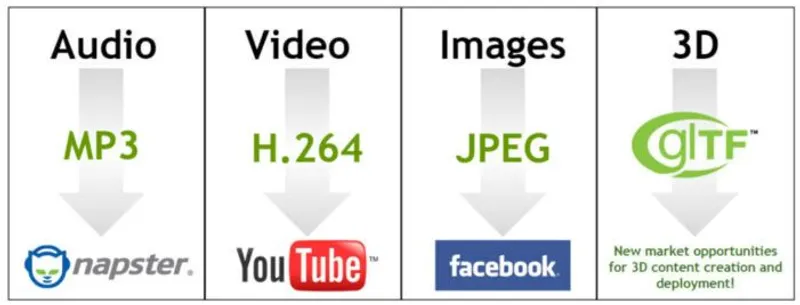
The need for an efficient format: The 2015 challenge and its aftermath – scaling up 3D processes Part 2/3
Table of Contents
Digital 3D technologies offer a lot of benefits in e-commerce and have the potential to transform the entire industry. Today’s technological and societal advances enable the technical realization of a 3D revolution. However, there are still many challenges on the way to scalable 3D processes, especially in industries new to 3D, like e-commerce. Just a few years ago an important milestone was achieved: the development of an efficient 3D delivery format called glTF. In this article, we will discuss the introduction of glTF, its adoption and the role it can play in the future.
The 2015 challenge: Devising an efficient 3D format
Five years ago, the e-commerce community was facing a challenge that limited the growth of 3D commerce use cases, which we can call the “2015 challenge” or, more concretely: the search for an efficient 3D delivery format. Loading speed and compatibility with common devices are essential when running an online shop. The user needs to have a good experience and be able to load a new page within 3 seconds. If it takes longer, well, then the shopper just continues to browse and leaves the product page. With JPEG it is not a problem to show multiple product images at once, as it is a compact format. Images can be crunched down to a few KB and still look very similar to the original. Even pages with multiple images can still be loaded quickly. This should be made possible for 3D too. For this we need an efficient 3D delivery format, as also John Carmack stated in 2016:
The world has long needed an efficient, usable standard for 3D scenes […] something at home on the internet, capable of being directly created and consumed by many different applications.
- John Carmack
Publication of New Format 2016
With the publication of the glTF format in 2016, the Khronos Group introduced a format that would be able to fulfil this need. Now, in 2020, glTF can be used on many platforms including Microsoft PowerPoint, which allows users to include digital 3D models in presentations. This is as easy as incorporating an image: just drag and drop the model into your slides, and you can even animate it as easily as animating imagery. Also, Microsoft Flight Simulator is using glTF for the import of assets. On Windows you can open 3D models with their native viewer too – if they are in glTF format. Google supports glTF as a content format for the new AR search. Looking at the mobile industry, for example the augmented reality framework for Android ARCore supports glTF. As can be seen, the format is widely accepted and adopted already.

Presentation of glTF in comparison with groundbreaking file formats from other media types such as audio, video or images, glTF being the “JPEG of 3D” – source: https://www.khronos.org/gltf/
Why is glTF so popular?
The popularity of glTF stems from many different factors. The compact design is “ready-to-render”, and it is an open, standardized and royalty-free format – therefore, easy to implement and validate. It has been designed together by engineers from many industry leading companies, such as Adobe, Autodesk and Microsoft, but also with involvement from Fraunhofer and our team at DGG. Its early adaption by technology leaders has made this format the de-facto standard for 3D content on the Web, and the Khronos consortium already labelled it the “JPEG of 3D”.
Role of glTF and USDZ
What glTF is for Android, Google and Microsoft, Pixar’s USDZ is for iOS and Apple. The two formats will play a major role in making 3D technology available to the mainstream. With native viewers on all devices the general public uses in their day-to–day life, viewing 3D content will be effortless and merge seamlessly into all kinds of activities like online shopping. Experts from over 70 industry leading companies are working on glTF within the Khronos Group to develop the format further. Succeeding in making glTF capable of fulfilling the specific requirements of different industries while at the same time keeping the benefits of the compact and efficient format will be another challenge.
Scaling up 3D in E-Commerce
Now that we can get compact models of fantastic quality onto all kinds of devices, it is necessary to look at 3D asset pipelines and find out what problems hold back a scalable production of real-time ready 3D models. Only if these processes can be made efficient and affordable, 3D technologies will be able to expand to mainstream applications.
If you missed our previous installment, you can find it in our blog: Why 3D in e-commerce.
Meet the Author

DGG Team
The 3D Pipeline Company
DGG is on a mission to connect the real and virtual by making 3D models as easy to handle as 2D images.
